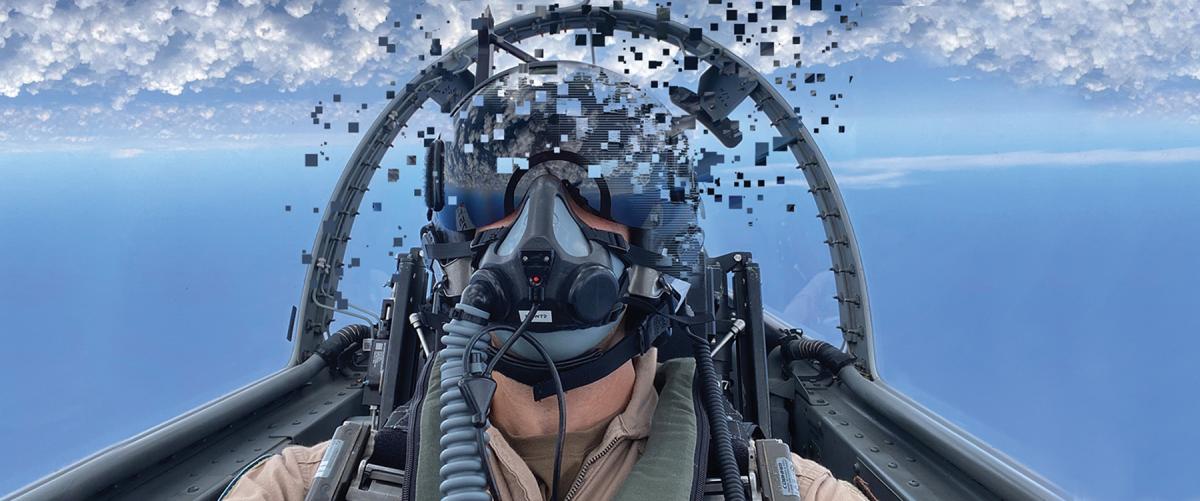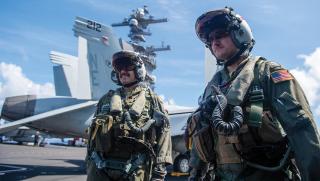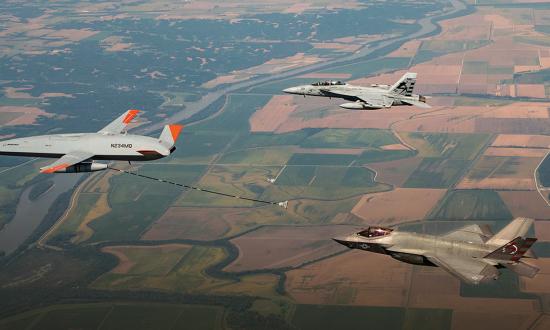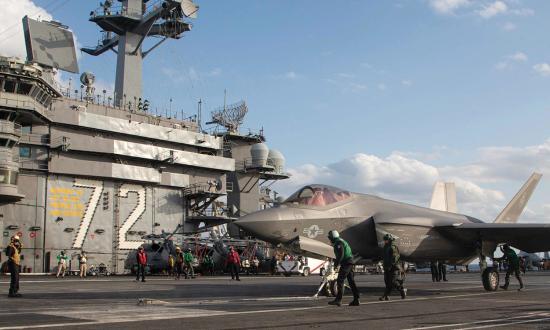Picture a battlefield where a drone swarm swirls around enemy ground forces, deploying weapons and countermeasures as needed. Behind that swarm is another providing cover fire and backup. Patrolling thousands of feet above is a single uncrewed reconnaissance aircraft, collecting video footage of the action below. That footage is sent back to a command-and-control center for analysis. Simultaneously, the footage (including coordinates and targeting information) is sent to two crewed strike-fighters loitering nearby with an uncrewed refueling aircraft. Once assigned to targets, the strike-fighters proceed to the battlefield and destroy the enemy. Above, the reconnaissance aircraft still circles, constantly recording and relaying data.
What is missing from this scene? Pilots. No longer science fiction, this scene illustrates the U.S. military’s trajectory toward relying on uncrewed assets to conduct warfare. As in current publicly released naval planning documents, this description focuses on equipment capabilities instead of the humans involved.1 By removing humans from the battlefield—specifically, pilots from cockpits—naval aviation is ignoring the growing pilot identity crisis. The shift from crewed aircraft to a hybrid environment presents an opportunity for naval aviation to learn from past technological transitions and leverage the full potential of both technology and humans.
Identity Crisis
In naval aviation, an entire identity is built around the pilot—a human physically sitting in an aircraft and flying it. Pilots are evaluated based on their ability to land, control, and maneuver an aircraft, including while engaging an enemy. These abilities have taken on mythical qualities, especially around fighter pilots, through movies such as Top Gun and The Right Stuff.
Aircraft and the entire naval aviation enterprise are designed around supporting this human-centric system. The introduction of more and more uncrewed aircraft—which pilots either operate from remote locations, or employ as battlespace commanders of multiple aircraft without directly controlling flight—challenges pilot identity.
Not only do identity challenges create conflict among personnel, but they also affect overall force effectiveness. When an old identity is challenged by a new technology, humans resist the changes and slow innovation to protect the identity.
Sailors Without Sails
The Navy has long struggled to acknowledge and manage human identity transitions brought about by new technologies. The switch from sail power to steam, for example, demanded new skills and made old ones obsolete. Though Robert Fulton created the first steam warship, the Fulton, in 1815, and the Navy was routinely building steamers by the 1850s and Monitor-class gunboats in the Civil War, sailless steam power for the oceangoing fleet was not fully implemented by the Navy until the first steel steamships were built in the 1880s.2
The primary propulsion method on naval vessels for hundreds of years, sails gave meaning to sailors and their jobs. Sailing equipment defined line officers’ lives, and, to those attached to sail power, steam stole “away the poetry of the sea, turn[ed] the sailor into a coal heaver, and the ship into a machine.”3
On board a sailing vessel, the line officer controlled the ship’s movement and propulsion by commanding personnel to manipulate the sails. However, as the engineers took over propulsion below decks on steamships, sail-based expertise slowly became obsolete, challenging the meaning and behavior associated with the line officer identity.
This identity conflict morphed into group conflict once line officers perceived the engineers as a distinct threat to their authority. They reestablished their dominance over engineers by slowing steam power development.
The Power of Collective Action
In 1869, the Board on Steam Machinery, controlled by line officers such as chairman Rear Admiral Louis M. Goldsborough, condemned the steamship Wampanoag and the rest of her class as “scarcely more than naval trash” despite the ship’s excellent performance.4 Based on previous ship designs, the board predicted that the Wampanoag would be hard to maneuver and roll in bad weather; but in the sea trials, conducted in bad weather, the steamship was labeled “remarkably steady, efficient, and easy” to handle.5 She also set a speed record as the fastest ship in the world at 16 knots.6
Almost a decade later, a group of more than 300 line officers, ranging from ensigns to rear admirals, signed a letter to the Secretary of the Navy stating that the “real root of the trouble lies deep in the discontent of the staff [including engineers] with their inevitable secondary importance to the organizing, commanding, military branch [line officers].”7 Both groups, representing the line officer community’s interests, sought to reestablish line officer dominance.
The Navy, embroiled in internal conflict, fell behind as the merchant marine and other navies embraced steam power and were operating hundreds of steam vessels by the mid-1800s.8 In 1881, Secretary of the Navy William Hunt declared that the Navy needed to modernize immediately or “it must soon dwindle into insignificance.”9 By the time the U.S. fleet embarked on the construction of its steam-powered “New Steel Navy” in 1883, it was years behind other navies.10
Precedent in Naval Aviation
Naval aviators also have rejected new technology based on identity concerns. In the 1960s, the Navy used the QH-50 drone antisubmarine helicopter (DASH), the first uncrewed U.S. rotary-wing aircraft, to extend antisubmarine warfare ranges from destroyers.11 These helicopters were modified for other missions such as bombing, gunfire spotting, cargo transfer, and intelligence collection, surveillance, and reconnaissance.
The DASH program suffered, however, because it did not fit pilot identity at the time. The uncrewed technology “challenged aviators who were focused on flying high and fast in manned jets.”12 Because pilots did not want any part of the DASH program, surface warfare officers operated the helicopters as a collateral duty, often without much training and only for a few months at a time. Consequently, once antisubmarine capabilities in crewed helicopters progressed through the light airborne multipurpose system, Congress defunded the DASH program because neither pilots nor surface warfare officers wanted it.13
Pilot Identity Attached to Physical Aircraft
From the Wright brothers’ first flight in 1903 to naval flight training today, pilots have been identified by their ability to physically operate an aircraft. That capability is further connected to beauty, danger, adventure, and bravery as one escapes “the surly bonds of Earth” and dances “the skies on laughter-silvered wings,” as described in John Magee’s famous poem “High Flight.”14
Pilots, like line officers of the sail era, use their specific skills to achieve their goals. A pilot’s ability to command a complex machine at high speeds and multiples of the force of gravity adds a daring element to their identity.15 Though terms such as “flying by the seat of your pants” have lost some meaning as aircraft controls have become more automated, pilot identity is still firmly rooted in combining unique training with operational experience in the cockpit. Like sail-era line officers, pilots attach their identity to the physical technology, as demonstrated by heated arguments between communities over which aircraft is better. The continued increase of uncrewed aircraft competing for missions threatens the dominance of crewed aircraft pilots because the physical root of their identity is being replaced. Being disconnected from the cockpit complicates translating their skills to uncrewed aircraft.
Despite its plan to increase uncrewed aircraft, the naval aviation enterprise is still centered around human pilots. Naval planning documents constantly use the terms “manned” and “unmanned” to distinguish between aircraft with and without pilots sitting in the cockpit.16 Just as calling naval personnel “sailors” forms an identity centered on sail, distinguishing aircraft based on human presence emphasizes the centrality of humans and reinforces traditional pilot identity. Reinforcing pilot centrality fails to acknowledge how the transition from crewed to uncrewed aircraft changes the pilot role from one of direct control inside an aircraft to one of a remote operator or battlefield manager. Even the carrier strike group is a support ecosystem built around projecting power via aircraft with pilots in the seats. Changing the pilot role requires a change in pilot identity.
Where do Aerial Vehicle Operators Fit?
The addition of aerial vehicle operators to pilot uncrewed aircraft, as a third group within naval aviation, challenges the dynamics in the service. Before aerial vehicle operators, naval aviation already had two competitive groups: pilots and naval flight officers (NFOs). In the 1960s, NFOs were not allowed to command squadrons because they did not control the aircraft.17 For years, certain command billets, such as the commanding officer of fleet squadrons, were restricted to pilots, preventing naval flight officers from competing on a level playing field.18 Consequently, the Navy perpetuated the perception that pilots were at the top of the aviation hierarchy. Though the Navy eventually removed command restrictions for NFOs, tension still exists between the two groups.
Creating a third category of aircraft operators is a conflict waiting to happen, especially regarding designation wings, career paths, and where they fit in naval aviation’s hierarchy. Now is the time to address these cultural issues because the first class of warrant officer aerial vehicle operators are training to operate the MQ-25 Stingray, the Navy’s new unmanned refueling aircraft.19 If pilots or naval flight officers perceive aerial vehicle operators as a different group of people and create an in-group/out-group mentality, this will drive harmful intergroup competition and hurt the Navy’s effectiveness.20
How to Resolve the Crisis
To minimize resistance to uncrewed aircraft, naval aviation should acknowledge the loss of the current pilot identity and create a common identity for operators of all aircraft types. All organizations with an organizational culture and identity going through technology change experience human resistance because the transition affects the organization’s social structure. Based on William Bridges’ transition model, organizations must manage the identity transition associated with technology change because identity-based resistance manifests in resentment, guilt, confusion, stress, and failure to adopt the new technology.21
Bridges argues the old identity must be completely removed and replaced with a new one that includes the new technology. In naval aviation, senior officers must lead the transition, and the changes in pilot identity need to be discussed at all levels, including flight school, individual squadrons, and higher-level commands. Simultaneously, the Navy must make an effort to foster a common identity for all personnel operating aircraft—crewed or uncrewed. The shared history of all naval aviators and all types of aircraft must be emphasized to help build a cohesive naval aviation culture.
While the Navy is adept at marketing aircraft performance capabilities, it is less proficient at handling abstractions such as the effect on values, beliefs, and identity. To increase adoption rates and tactical innovation, Navy leaders should explain the relative advantages of uncrewed aircraft, but also emphasize uncrewed aircraft compatibility with the old identity, values, and experience.22
Furthermore, naval aviation leaders must minimize conflict between crewed and uncrewed operators and form a unified cadre of effective warfighters. To promote this unity, naval aviation leaders and personnel need to be aware of how change affects people at a psychological level. Aircraft terms should not revolve around human presence; the current terms, “manned” and “unmanned,” automatically create a division between pilots and aerial vehicle operators. In addition, differentiating between naval aviators and aerial vehicle operators with the terms “pilot” and “operator” invites competition for dominance.
The Navy’s organizational structure and proposed career paths for pilots and operators also should reinforce unity. By leading the psychological transition from crewed to uncrewed aircraft and ensuring all operators have viable career paths, leaders will minimize internal conflict and increase naval aviation’s ability to project a united front against adversaries.
Don’t Forget the Humans
Naval aviation leaders need to consider human identity issues in the current transition from crewed to uncrewed aircraft. Just as the U.S. Navy fell behind peer navies in the late 1800s when it was slow to let go of the culture of sail, internal conflict today threatens naval aviation’s ability to innovate and make the most of current and future aircraft—whether they have pilots in cockpits or not. Humans are a constant factor in every military technological transition. The Navy cannot afford to overlook them.
1. NAVAIR, Navy Aviation Vision 2030–2035 (San Diego, CA: NAVAIR, 2021); Department of the Navy, Department of the Navy Unmanned Campaign Framework (Washington, DC: Department of the Navy, 2021); and Department of the Navy, Department of the Navy Strategic Roadmap for Unmanned Systems (Washington, DC: Department of the Navy, 2018).
2. Frank M. Bennett, The Steam Navy of the United States: A History of the Growth of the Steam Vessel of War in the U.S. Navy, and of the Naval Engineer Corps (Pittsburgh, PA: Warren & Co., 1896), 12; and Naval History and Heritage Command, “Steam Navy,” 19 July 2019, www.history.navy.mil/browse-by-topic/wars-conflicts-and-operations/steam-steel-navy.html.
3. Bennett, The Steam Navy of the United States, 31.
4. Department of the Navy, Annual Report of the Secretary of the Navy, vol. 1411 (U.S. Government Printing Office, 1869), 207.
5. Elting E. Morison, Men, Machines, and Modern Times (Cambridge, MA: MIT Press, 1966), 115.
6. Lance C. Buhl, “Mariners and Machines: Resistance to Technological Change in the American Navy, 1865–1869,” The Journal of American History 61, no. 3 (1974): 708.
7. Line Officers, “Letter to Secretary of the Navy,” 22 January 1878, 10, www.navyhistory.org/wp-content/uploads/2013/04/22Jan1878ltrtoSECNAV.pdf.
8. Bennett, The Steam Navy of the United States, 16.
9. Bennett, 551.
10. Naval History and Heritage Command, “Steam Navy.”
11. Laurence R. Newcome, Unmanned Aviation: A Brief History of Unmanned Aerial Vehicles (Reston, VA: American Institute of Aeronautics and Astronautics, Inc., 2004), 83.
12. CDR Benjamin Armstrong, USN, “DASH, Snoopy, and the Night Panther,” Naval History 30, no. 3 (June 2016).
13. Armstrong, “DASH, Snoopy, and the Night Panther.”
14. Michael R. Patterson, “High Flight,” 8 February 2008, Arlington National Cemetery, web.archive.org/web/20080208223722/http://woodiescciclub.com/high-flight.htm.
15. CAPT Robert C. Rubel, USN (Ret.), “The U.S. Navy’s Transition to Jets,” Naval War College Review 63, no. 2 (Spring 2010): 56.
16. NAVAIR, Navy Aviation Vision 2030–2035; Department of the Navy, Department of the Navy Strategic Roadmap for Unmanned Systems; and Department of the Navy, Department of the Navy Unmanned Campaign Framework.
17. LCDR Stephen F. Loftus, USN, “Career Development for the Naval Flight Officer,” U.S. Naval Institute Proceedings 94, no. 5 (May 1968): 57–65.
18. Loftus, “Career Development for the Naval Flight Officer.”
19. Darwin Lam, “First Warrant Officer Aerial Vehicle Operators Graduate from Officer Candidate School,” DVIDS, 28 January 2022.
20. Henry Tajfel et al., “An Integrative Theory of Intergroup Conflict,” in Organizational Identity: A Reader (New York: Oxford University Press, 1979), 56.
21. William Bridges, Managing Transitions: Making the Most of Change, 2nd ed. (Cambridge, MA: Perseus, 2003), x; and Everett M. Rogers, Diffusion of Innovations, 5th ed. (New York: Simon and Schuster, 2003), 36.
22. Based on Everett Rogers’ Diffusion of Innovations model. Adoption rates are influenced by relative advantage, compatibility, complexibility, trialability, and observability of the new technology. See: Rogers, Diffusion of Innovations, 240, 257.








